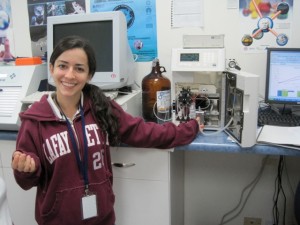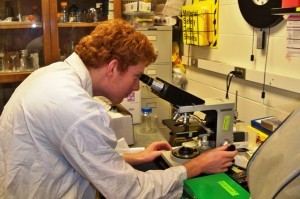
Elizabeth Wilson '13
“This research has real-world applications and translates so well to human behavior,” says Elizabeth Wilson ’13 (Beaver Meadows, Pa.). “I didn’t think I really wanted to be working in a lab after graduation, but I’ve changed my mind and am actually applying to some graduate programs. I hope to either go to medical school or grad school.”
Wilson did research with Gabrielle Britton, principal investigator of the Center for Neuroscience at INDICASAT AIP, a biomedical research institute in Panama, through the LafayettE Alumni Research Network (LEARN). The program pays for a select number of students each summer to have eight to ten weeks of full-time research with a Lafayette graduate or associate working in the neuroscience field. LEARN, now in its 10th year, was established in part through a grant from the McCutcheon Foundation.
Britton is not an alumnus, but she taught at Lafayette for many years. Her research with Wilson focused on standardizing the measurement of catecholamines (i.e. dopamine and adrenaline) and their small molecules in brain tissue. The goal is to understand how stress, age, and sex combine to modify catecholamines in rat brains.
“LEARN allows students to step outside Lafayette and see how other labs conduct [experiments]. It is also an opportunity to expand students’ technical skills and apply this knowledge to their research at Lafayette,” says Britton.
Nick Navara ’13 (East Brunswick, N.J.) spent the summer working with James Simmons ’65, professor of neuroscience at Brown University in Providence, R.I.
“We have hosted a LEARN student every summer for about a decade, and we are very happy to have such good students join us for a few months,” says Simmons. “A LEARN student from two years ago, Alyssa Wheeler ’10, is now a graduate student in our program.”

Tyler Basting '12
Navara and Simmons studied bat sonar systems. They listened to recordings of bat calls and gathered information on the way the bats emit their calls in order to navigate areas with dense vegetation and tall trees, as well as insects and other bats.
“Following these excursions, we then looked at the length and frequencies of the bats’ sonar emissions to see how the bats use their calls with echolocation,” says Navara.
After Navara graduates from Lafayette, he plans on either participating in research on neurological diseases or going on to medical school to be a neurosurgeon. This summer, he will serve an internship at New York-Presbyterian Hospital/Weill Cornell Medical Center in its neurological surgery department.
“This research has helped shape my goals by only providing me with more to chase after,” he says. “Now that I have spent time in a professional laboratory, I want to experience more. I want to try out other labs that are looking at different topics and see how I like them.”
Lisa Schrott ’87, associate professor of pharmacology, toxicology, and neuroscience at Louisiana State University Health Sciences Center-Shreveport, worked with Tyler Basting ’12 (Dover Plains, N.Y.).
“We have been using a drug that increased endogenous marijuana-like substances (cannabinoids) in the brain to prevent nausea and vomiting that are associated with opioids like Oxycontin that are given for pain management,” says Schrott. “Tyler’s project involved determining if one region of the brain, the amygdala, gets activated by the drug combination.
“Spending a summer conducting research at a research-intensive medical school gives undergraduates the hands-on experience to know what it will be like in graduate school. It also gives them an idea of the type of work and the areas of study that they might like to tackle in the future.”
Three former LEARN students who spent the summer in Schrott’s laboratory (Sylvina Mullins ’07, Ashley Juavinett ’11, and Ioana Marin ’11) are in graduate school working on Ph.Ds in neuroscience. Arda Hotz ’08 is in medical school and Jaime Abbazia ’05 has graduated from pharmacy school.
“Participating in the LEARN program is a wonderful way to give back to the Lafayette community,” says Schrott. “Living in Louisiana, I don’t encounter too many ’Pards and the LEARN program helps keep me connected to the campus. It is exciting to see Lafayette through the eyes of a new generation of scholars.”
Chris Sanginiti ’12 (Newtown, Pa.) researched with Pete Donovick ’61, professor of psychology at Binghamton University. Their work focused primarily on the effects of stereotyping on cognitive ability.
“The research was interesting because it has many real-life applications,” says Sanginiti. “Our research focused primarily on elderly populations and their associated stereotypes, i.e. reduced memory.”
After graduating from Lafayette, Sanginiti plans on going to dental school, with the hopes of becoming a dental surgeon.
“The LEARN program is a great opportunity to do in-depth research in an area not necessarily available at Lafayette,” he says. “It teaches you a variety of new skills and above all teaches you to manage and investigate your own research question.”


1 Comment
Comments are closed.